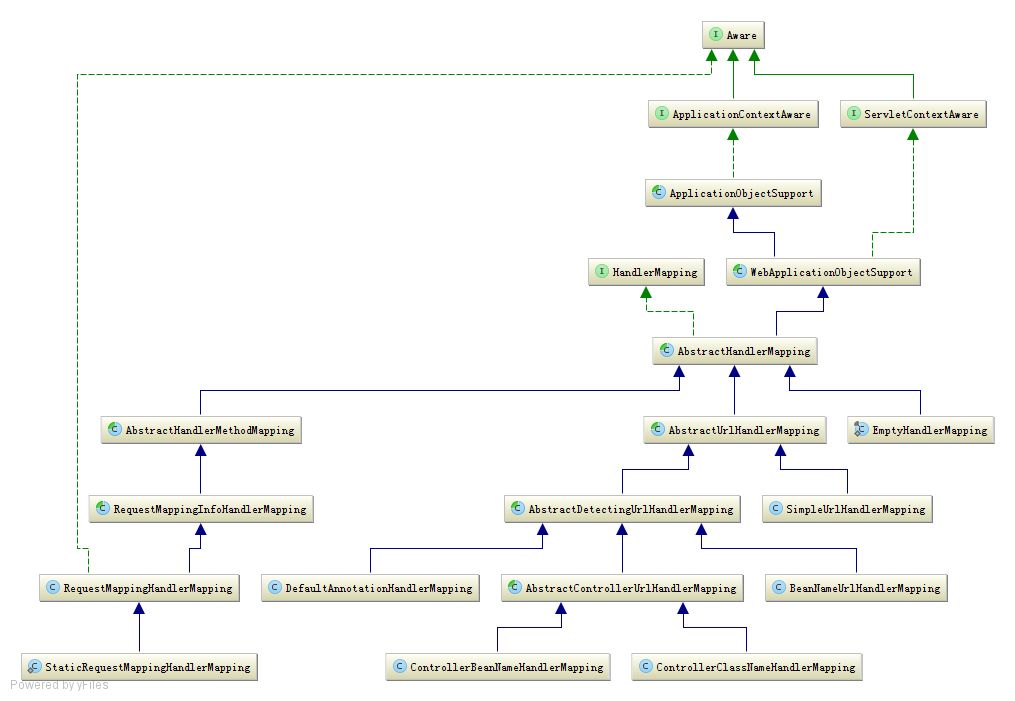SpringMVC的流程分析(二)—— HandlerMapping组件
1.HandlerMapping的类结构

如上图所示,HandlerMapping接口有一个叫做;getHandler()的方法,这个方法是用来回去HandlerMapping对应的处理器的,由此也就可以看出HandlerMapping主要是用来映射请求和处理器的。
AbstractHandlerMapping实现了HandlerMapping接口,还继承了WebApplicationObjectSupport,而WebApplicationObjectSupport最终实现了ApplicationContextAware接口,这个接口使用来扩展
Spring的,ApplicationContextAware可以对应用上下文进行加工,加入自己的逻辑,SpringMVC就是通过它来实现的url和处理器的映射。
接下来我们看到AbstractHandlerMethodMapping和AbstractUrlHandlerMapping都继承了AbstractHandlerMapping,这两个类分别从不同的角度来映射请求和处理器。
2.AbstractHandlerMapping具体的实现
2.1 AbstractUrlHandlerMapping
我们分开来看,首先分析AbstractUrlHandlerMapping,这个类是用来映射url和handler的,它维护了一个handlerMap用来存储url相应的处理器,它的实现类AbstractDetectingUrlHandlerMapping重写了
initApplictionContext()方法:
@Override
public void initApplicationContext() throws ApplicationContextException {
super.initApplicationContext();
detectHandlers();
}
可以看到他调用了父类的initApplicationContext方法,然后又调用了detectHandlers()方法来处理请求映射,看detectHandler()源码:
protected void detectHandlers() throws BeansException {
String[] beanNames = (this.detectHandlersInAncestorContexts ?
BeanFactoryUtils.beanNamesForTypeIncludingAncestors(getApplicationContext(), Object.class) :
getApplicationContext().getBeanNamesForType(Object.class));
// Take any bean name that we can determine URLs for.
for (String beanName : beanNames) {
String[] urls = determineUrlsForHandler(beanName);
if (!ObjectUtils.isEmpty(urls)) {
// URL paths found: Let's consider it a handler.
registerHandler(urls, beanName);
}
else {
if (logger.isDebugEnabled()) {
logger.debug("Rejected bean name '" + beanName + "': no URL paths identified");
}
}
}
}
第一步,获取所有的beanname,第二步,根据这个beanName查询它是不是一个处理器,并取出他的url,
determineUrlsForHandler有多种实现,我们拿AbstractControllerUrlHandlerMapping举例说明:
@Override
protected String[] determineUrlsForHandler(String beanName) {
Class<?> beanClass = getApplicationContext().getType(beanName);
if (isEligibleForMapping(beanName, beanClass)) {
return buildUrlsForHandler(beanName, beanClass);
}
else {
return null;
}
}
首先从应用上下文中根据beanname获取到bean的class对象,然后判断有没有成为处理器的资格,即判断是否实现了Controller接口。
然后调用buildUrlsForHandler()方法获取处理器的url,然后返回。
接下来执行 registerHandler(urls, beanName) :
protected void registerHandler(String[] urlPaths, String beanName) throws BeansException, IllegalStateException {
Assert.notNull(urlPaths, "URL path array must not be null");
for (String urlPath : urlPaths) {
registerHandler(urlPath, beanName);
}
}
registerHandler(url,beanname)
protected void registerHandler(String urlPath, Object handler) throws BeansException, IllegalStateException {
Object resolvedHandler = handler;
// Eagerly resolve handler if referencing singleton via name.
if (!this.lazyInitHandlers && handler instanceof String) {
String handlerName = (String) handler;
if (getApplicationContext().isSingleton(handlerName)) {
resolvedHandler = getApplicationContext().getBean(handlerName);
}
}
Object mappedHandler = this.handlerMap.get(urlPath);
if (mappedHandler != null) {
if (mappedHandler != resolvedHandler) {
throw new IllegalStateException(
"Cannot map " + getHandlerDescription(handler) + " to URL path [" + urlPath +
"]: There is already " + getHandlerDescription(mappedHandler) + " mapped.");
}
}
else {
if (urlPath.equals("/")) {
if (logger.isInfoEnabled()) {
logger.info("Root mapping to " + getHandlerDescription(handler));
}
setRootHandler(resolvedHandler);
}
else if (urlPath.equals("/*")) {
if (logger.isInfoEnabled()) {
logger.info("Default mapping to " + getHandlerDescription(handler));
}
setDefaultHandler(resolvedHandler);
}
else {
this.handlerMap.put(urlPath, resolvedHandler);
if (logger.isInfoEnabled()) {
logger.info("Mapped URL path [" + urlPath + "] onto " + getHandlerDescription(handler));
}
}
}
}
首先从上下文拿到一个处理器实例,然后根据url的不同,将它设置到不同的处理器存储位置,例如,如果url是"/"就将处理器设置为根处理器,
如果url是"/*"就将处理器设置为默认处理器。如果都不是就放进handleMap中。
通过以上步骤,我们就将上下文中所有的bean循环了一遍,只要是符合HandlerMapping的规则的处理器,就会将他的映射关系存储起来。
2.2 AbstractHandlerMethodMapping
AbstractHandlerMethodMapping和AbstractUrlMethodMapping有所不同,他实现了InitializingBean接口,通过实现afterPropertiesSet()方法来扩展相应的业务
public void afterPropertiesSet() {
initHandlerMethods();
}
调用了initHandlerMethods()
protected void initHandlerMethods() {
String[] beanNames = (this.detectHandlerMethodsInAncestorContexts ?
BeanFactoryUtils.beanNamesForTypeIncludingAncestors(getApplicationContext(), Object.class) :
getApplicationContext().getBeanNamesForType(Object.class));
for (String beanName : beanNames) {
if (!beanName.startsWith(SCOPED_TARGET_NAME_PREFIX) &&
isHandler(getApplicationContext().getType(beanName))){
detectHandlerMethods(beanName);
}
}
handlerMethodsInitialized(getHandlerMethods());
}
首先获取所有的beanname,然后遍历这些bean,判断他是不是处理器,不同的实现有不同的判断方法,那我们最常用的@Controller为例说明
protected boolean isHandler(Class<?> beanType) {
return ((AnnotationUtils.findAnnotation(beanType, Controller.class) != null) ||
(AnnotationUtils.findAnnotation(beanType, RequestMapping.class) != null));
}
判断这个类有没有@Controller或者@ReuqestMapping注解就可以了.
接下来执行detectHandlerMethods(beanName)
protected void detectHandlerMethods(final Object handler) {
Class<?> handlerType =
(handler instanceof String ? getApplicationContext().getType((String) handler) : handler.getClass());
// Avoid repeated calls to getMappingForMethod which would rebuild RequestMappingInfo instances
final Map<Method, T> mappings = new IdentityHashMap<Method, T>();
final Class<?> userType = ClassUtils.getUserClass(handlerType);
Set<Method> methods = HandlerMethodSelector.selectMethods(userType, new MethodFilter() {
@Override
public boolean matches(Method method) {
T mapping = getMappingForMethod(method, userType);
if (mapping != null) {
mappings.put(method, mapping);
return true;
}
else {
return false;
}
}
});
for (Method method : methods) {
registerHandlerMethod(handler, method, mappings.get(method));
}
}
可以看到它首先会得到所有的方法,然后对方法进行过滤,调用matches方法,还是拿@Controller举例:
protected RequestMappingInfo getMappingForMethod(Method method, Class<?> handlerType) {
RequestMappingInfo info = null;
RequestMapping methodAnnotation = AnnotationUtils.findAnnotation(method, RequestMapping.class);
if (methodAnnotation != null) {
RequestCondition<?> methodCondition = getCustomMethodCondition(method);
info = createRequestMappingInfo(methodAnnotation, methodCondition);
RequestMapping typeAnnotation = AnnotationUtils.findAnnotation(handlerType, RequestMapping.class);
if (typeAnnotation != null) {
RequestCondition<?> typeCondition = getCustomTypeCondition(handlerType);
info = createRequestMappingInfo(typeAnnotation, typeCondition).combine(info);
}
}
return info;
}
可以看到他是判断方法有没有RequestMapping注解来过滤方法的,所有过滤出来的方法都会生成一个 RequestMappingInfo,(它包含该方法的所有的注解信息),放进maps里面,
接下来就是将所有的方法进行注册:
protected void registerHandlerMethod(Object handler, Method method, T mapping) {
HandlerMethod newHandlerMethod = createHandlerMethod(handler, method);
HandlerMethod oldHandlerMethod = this.handlerMethods.get(mapping);
if (oldHandlerMethod != null && !oldHandlerMethod.equals(newHandlerMethod)) {
throw new IllegalStateException("Ambiguous mapping found. Cannot map '" + newHandlerMethod.getBean() +
"' bean method \n" + newHandlerMethod + "\nto " + mapping + ": There is already '" +
oldHandlerMethod.getBean() + "' bean method\n" + oldHandlerMethod + " mapped.");
}
this.handlerMethods.put(mapping, newHandlerMethod);
if (logger.isInfoEnabled()) {
logger.info("Mapped \"" + mapping + "\" onto " + newHandlerMethod);
}
Set<String> patterns = getMappingPathPatterns(mapping);
for (String pattern : patterns) {
if (!getPathMatcher().isPattern(pattern)) {
this.urlMap.add(pattern, mapping);
}
}
if (this.namingStrategy != null) {
String name = this.namingStrategy.getName(newHandlerMethod, mapping);
updateNameMap(name, newHandlerMethod);
}
}
首先创建一个HandlerMethod对象,用来包装处理器和对应的方法。然后判断是否有重复的handlermethod,然后将映射类和处理类放进handlerMethods中,
可以看到,他还会将url和映射信息放进一个urlMap来记录,这说明多个请求可能对应同一个映射。
以上就是HandlerMapping的大体作用和流程信息,用来呈放web应用的映射信息,关于如何根据request寻找到对应的映射器,将在下一章介绍。
SpringMVC的流程分析(二)—— HandlerMapping组件的更多相关文章
- 框架-springmvc源码分析(二)
框架-springmvc源码分析(二) 参考: http://www.cnblogs.com/leftthen/p/5207787.html http://www.cnblogs.com/leftth ...
- SpringMVC的流程分析(一)—— 整体流程概括
SpringMVC的整体概括 之前也写过springmvc的流程分析,只是当时理解的还不透彻所以那篇文章就放弃了,现在比之前好了些,想着写下来分享下,也能增强记忆,也希望可以帮助到人,如果文章中有什么 ...
- Android 7.1 WindowManagerService 屏幕旋转流程分析 (二)
一.概述 从上篇[Android 7.1 屏幕旋转流程分析]知道实际的旋转由WindowManagerService来完成,这里接着上面具体详细展开. 调了三个函数完成了三件事,即首先调用update ...
- Gradle之Android Gradle Plugin 主要流程分析(二)
[Android 修炼手册]Gradle 篇 -- Android Gradle Plugin 主要流程分析 预备知识 理解 gradle 的基本开发 了解 gradle task 和 plugin ...
- Android 4.4 音量调节流程分析(二)
之前在Android 4.4 音量调节流程分析(一)里已经有简单的分析音量控制的流程,今天想接着继续分析下音量大小计算的方法.对于任一播放文件而言其本身都有着固定大小的音量Volume_Max,而在A ...
- MSM8909中LK阶段LCM屏适配与显示流程分析(二)
1.前言 在前面的文章MSM8909中LK阶段LCM屏适配与显示流程分析(一),链接如下: https://www.cnblogs.com/Cqlismy/p/12019317.html 介绍了如何使 ...
- Uboot启动流程分析(二)
1.前言 在前面的文章Uboot启动流程分析(一)中,链接如下: https://www.cnblogs.com/Cqlismy/p/12000889.html 已经简单地分析了low_level_i ...
- Netty执行流程分析与重要组件介绍
一.环境搭建 创建工程,引入Netty依赖 二.基于Netty的请求响应Demo 1.TestHttpServerHandle 处理器.读取客户端发送过来的请求,并且向客户端返回hello worl ...
- Nginx-HTTP之静态网页访问流程分析二
11. HTTP 阶段执行 下面会依次执行以下阶段: NGX_HTTP_SERVER_REWRITE_PHASE: 在将请求的 URI 与 location 表达式匹配前,修改请求的 URI (所谓重 ...
随机推荐
- JDBC(通俗易懂)简单的操作(增、删、改、查)
项目所写的类: 说明:①.DButil 动态加载数据库驱动,以及获取java.sql.Connection的对象. ②.Personmodel 数据库列(栏位)所对应的字段,定义了相应的set和get ...
- ElasticSearch的安装
一.安装javaSE环境(已配java环境变量的请直接跳过) 1.从Java JDK 官网下载适合自己的jdk版本.(我自己用的jdk1.7) 2.安装jdk后,配置java环境变量(ps:比较喜欢简 ...
- mysql新手入门随笔2
17.创建表 CREATE TABLE tbname(columnname1 类型 约束条件, columnname2 类型 约束条件,-); 三大类型:数值型,时间日期型,字符串类型 六大约束条件: ...
- 每天学习点js(2)
在日常开发中可能有很多不被重视但有关系着基础的知识,下面我们就来看看这几道题吧 题1 ["1","2","3"].map(parseInt) ...
- Android实用代码七段(三)
正文 一.获取已经安装APK的路径 PackageManager pm = getPackageManager(); for (ApplicationInfo app : pm.getInstall ...
- NODE_ENV 不是内部或外部命令,也不是可运行的程序,或者批处理文件
今天碰到一个奇葩问题,mac上能执行的npm命令,到windows上执行不聊了,报这个错 NODE_ENV 不是内部或外部命令,也不是可运行的程序,或者批处理文件 这是怎么回事呢?听我慢慢道来. &q ...
- linux小白成长之路7————Docker安装mysql
[内容指引] 从Docker检索mysql镜像: Mysql Docker镜像下载: 查看本地镜像列表: 设置Mysql的Docker镜像开机自动运行: 常用Docker指令及参数: 1.从Docke ...
- ReentrantLock 与 AQS 源码分析
ReentrantLock 与 AQS 源码分析 1. 基本结构 重入锁 ReetrantLock,JDK 1.5新增的类,作用与synchronized关键字相当,但比synchronized ...
- 使用jmeter+ant进行接口自动化测试(数据驱动)之一:设计jmeter脚本
最近在做接口测试,因为公司有使用jmeter做接口测试的相关培训资料,所以还是先选择使用jmeter来批量管理接口,进行自动化测试.话不多说,进入正题: 1.使用csv文件保存接口测试用例,方便后期对 ...
- alpha-咸鱼冲刺day4
一,合照 emmmmm.自然还是没有的. 二,项目燃尽图 三,项目进展 QAQ具体工作量没啥进展.但是前后端终于可以数据交互了!.. 四,问题困难 日常啥都不会,百度真心玩一年. 还得自学nodejs ...
